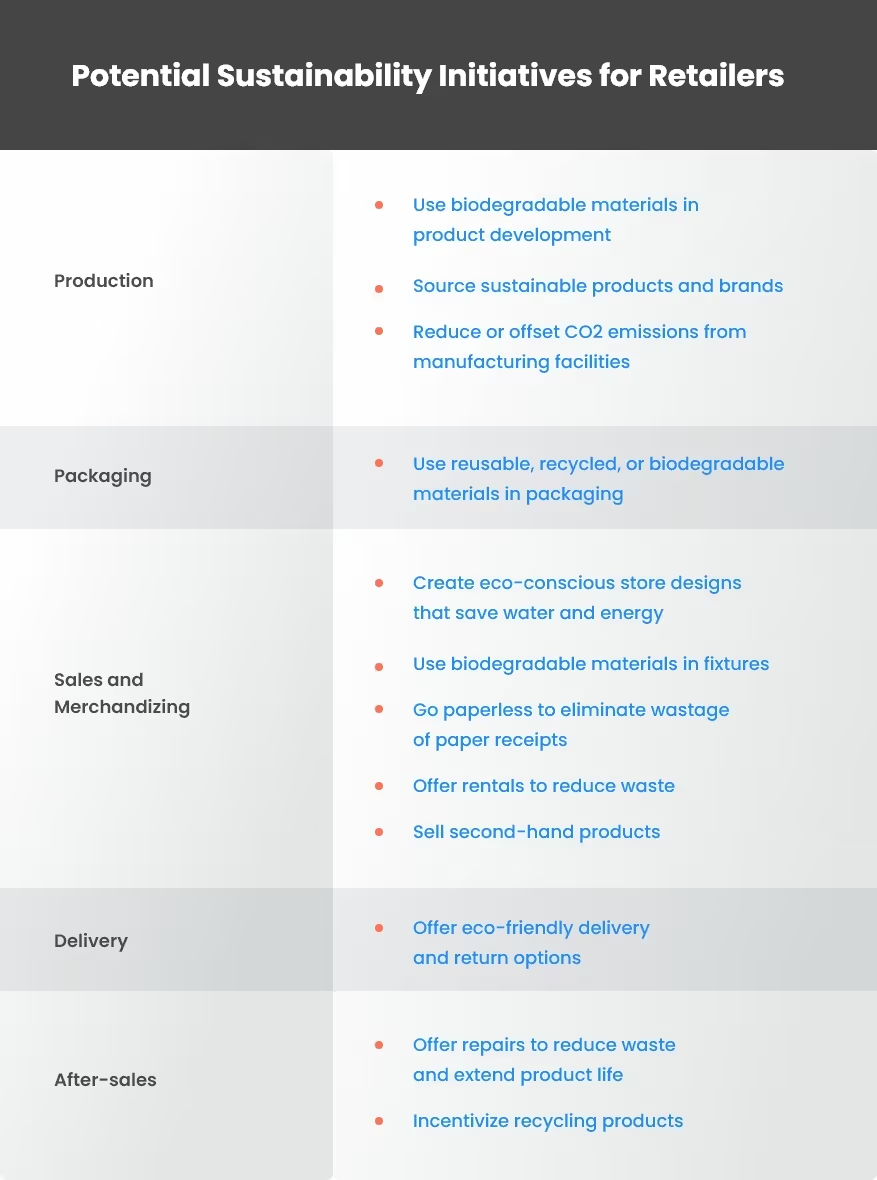Sustainability is the ability to exist without disturbing the ecological balance. While it involves social and economic aspects as well, sustainability most commonly refers to an effort to protect the environment and conserve resources for future generations. For retailers, sustainable business practices are now an important need — because consumers today are beginning to care about sustainability more than they ever have before. Launched in 2020 by the United Nations Development Programme (UNDP), the Peoples' Climate Vote is a survey of people across 50 countries, covering more than half the world’s population. In 2021, the survey had 1.2 million respondents, making this the largest ever public opinion survey on climate change. The survey found that 64 percent of respondents thought climate change was an emergency. With most people today concerned about sustainability, it’s time for retailers to start building sustainability into their strategy as well. One of the ways that retailers can do this is by adopting collaborative commerce. In this article, we’ll explore how collaborative commerce models can help retailers optimize their operations, lower carbon emissions, and reduce waste — and how all this helps them boost customer loyalty and market share.
Why should retailers care about sustainability?

This shift in consumer concerns is starting to affect purchase decisions in a big way. A 2020 Forrester survey found that 57 percent of consumers plan to buy from companies that contribute to sustainability more frequently over the next two years. And the pandemic has heightened these concerns — a 2020 study conducted by research firm GWI found that 72 percent of consumers from 20 countries cared more about companies behaving sustainably because of COVID-19. Most of all, sustainability and climate change are top concerns for Gen Z and millennial retail customers. Many consumers from these generations will use it as a factor when deciding who to buy from. To capture this large market, retailers have to adopt sustainable practices. For these reasons, sustainability in ecommerce has become the next big milestone. Not just for its value as a Corporate Social Responsibility (CSR) initiative — but also because sustainability initiatives by online marketplaces and ecommerce shops are becoming a way to stand out. For some fashion brands like Tentree, Everlane, and People Tree, sustainability is a core business fundamental rather than a growth strategy — and this really resonates with their audience. Efforts such as reducing their carbon footprint, minimizing waste, and practicing fair trade help businesses differentiate, build customer loyalty, and increase profitability — while also making a difference in the world. One of the ways that businesses can begin the journey towards becoming more socially responsible is by following Environmental, Social, and Governance (ESG) criteria. ESG can be seen as a set of guidelines that retailers should follow to act ethically and responsibly. Sustainability, environmental concerns, human rights issues, corruption, labor standards — all these factors are included in ESG assessments. While there isn’t any one standard for ESG assessment, the UN Global Compact can be a good place to start. The shift towards sustainability in ecommerce can also be seen in the heightened interest in reselling and reusing pre-owned products — also known as recommerce or circular commerce. Recommerce helps reduce waste and gives consumers access to high-quality products at affordable rates. Several online marketplaces for second-hand clothing and footwear are now taking advantage of this trend, such as Vinted, Vestiaire Collective, and ThredUp. Many major brands such as Levi’s, Lululemon, and Patagonia have also chosen to enter the second-hand goods market. But this shift isn’t only consumer-led. The 2021 United Nations Climate Change Conference, held in Glasgow with 197 participating countries, illustrates how governments and businesses are also tasked with reducing emissions, reversing deforestation, and other measures to slow down global warming. All this indicates that retailers need to actively start implementing sustainability initiatives across production, packaging, messaging, as well as delivery methods. Read 7 Ways to Encourage Impulse Buys on Your E-Commerce Platform
Not all sustainability initiatives are equal
There are many different ways to approach sustainability in ecommerce, such as by adopting ethical production standards, using more environmentally-friendly materials, using compostable or recycled packaging materials, eliminating unnecessary and wasteful packaging, and lowering return rates.

But as more and more brands jump on the eco-conscious bandwagon, consumers also grow wary and question their commitment. Today’s consumers can easily see through the greenwashing — marketing tactics used by brands to appear eco-friendly without making a substantial effort in that direction. Brands that overstate their sustainability efforts, make false claims or fail to show the data to back their claims will, sooner or later, lose the trust of consumers. The brands that last will be those that put impact before optics. And as supply chains create 90 percent of companies’ environmental impact, this necessitates moving towards more efficient operations and logistics practices. Read The 7 Secrets of E-commerce Giants – And What You Can Learn From Them
Marketplaces for a win-win

One of the ways that retailers can hit several of these targets at once is by adopting collaborative commerce. Collaborative commerce involves working in partnership with sellers to offer more choice and value to customers — for instance, setting up an online marketplace where many sellers come together to sell their products on a single platform. Retail businesses can leverage the marketplace model to become more sustainable, especially in terms of their global operations. Rather than moving inventory from one place to another, marketplace owners can work with local sellers and suppliers to deliver locally. By moving fulfillment closer to the customer, they reduce overheads like logistics, electricity, warehousing, etc. This makes the marketplace paradigm a far more sustainable model for retail businesses to operate in, allowing them to reduce their carbon emissions from sales to delivery. Recommerce marketplaces take this a step further — by reselling and recycling pre-owned products, they reduce wastage and reduce retailers’ carbon emissions right from the production stage. The marketplace model also responds to consumers’ drive to buy local, especially post-pandemic, and sustain local economies. Accenture finds that 56 percent of consumers are shopping in neighborhood stores or buying locally sourced products — 79 percent and 84 percent respectively plan to continue doing so. Collaborative commerce can be the way that many small businesses work alongside each other to serve local communities and thrive. Today, marketplace solution providers like Marketcube make it very easy to set up an online marketplace within a matter of hours or days instead of several months.Read Vertical Marketplaces: The Defining E-Commerce Trend
Sustainability — not greenwashing — builds trust
Sustainability is good for business, helping retailers become more efficient in their processes, achieve faster growth, and create more value for consumers — and it will continue to be important in the years to come.Retailers must start thinking about how they can become more sustainable today. While there are many different ways to do this, today’s consumers are highly discerning and can tell when brands are being inauthentic. Sustainability initiatives by online marketplaces and ecommerce stores that aren’t launched with the intent of having a meaningful impact on the environment and local communities won’t get retailers far. Instead, retailers should consider ways to really make a meaningful difference to society. New retail models such as collaborative commerce are placed at an enticing intersection, addressing both customers’ and retailers’ concerns. By adopting the marketplace model, retail business owners can easily achieve their sustainability goals and also gain loyal customers. Once retailers have begun to prioritize sustainability in ecommerce, they’ll also be able to confidently communicate to stakeholders how green they are, making it easier to gain their trust. Companies like Collabofide are making this easier by providing businesses with a way to showcase their ESG commitment. Collabofide’s trust agents assess online platforms against international ESG standards and best practices. Through these assessments, retailers can have their sustainability efforts validated, making them more trustworthy and appealing in the eyes of their customers. By adopting more sustainable retail models such as collaborative commerce, and working towards greater transparency via independent assessments, retailers can gain the loyalty of their customers and capture a larger market share. Read The Ultimate Go-To-Market Strategy for Your Online Marketplace
.avif)










.jpg)









